 I called our local large animal veterinary hospital, Pilchuck Veterinary Hospital, to inquire about doing a parasite load count on my sheep. No can do. Pilchuck no longer offers services for small ruminants. They will still work on sheep and goats brought to their clinic, but for emergencies only. Their website lists four vets who specialize in goats, sheep and llamas- I guess this must be out of date?
I called our local large animal veterinary hospital, Pilchuck Veterinary Hospital, to inquire about doing a parasite load count on my sheep. No can do. Pilchuck no longer offers services for small ruminants. They will still work on sheep and goats brought to their clinic, but for emergencies only. Their website lists four vets who specialize in goats, sheep and llamas- I guess this must be out of date?
Category: Farming
Princess and the Pea: The Pursuit of a PC LGD Bed
 An update for those who may still be losing sleep at night wondering if our livestock guardian dog, Bronte, has adequate shelter or not. I had originally built her an A-frame style house. I find that usually dogs prefer a cozy, den-like space for sleeping, as opposed to spacious ones, so I made it just her size. Dogs in my house will often cram into a cat crate or squish under a desk to take a nap, rather than choosing the broad, cushy beds I lay in the middle of the floor for them, or even the couch. There is just no accounting for their tastes, but I suspect it’s due to some long-harbored instinct to snooze in a protected space that conserves heat. Or something.
An update for those who may still be losing sleep at night wondering if our livestock guardian dog, Bronte, has adequate shelter or not. I had originally built her an A-frame style house. I find that usually dogs prefer a cozy, den-like space for sleeping, as opposed to spacious ones, so I made it just her size. Dogs in my house will often cram into a cat crate or squish under a desk to take a nap, rather than choosing the broad, cushy beds I lay in the middle of the floor for them, or even the couch. There is just no accounting for their tastes, but I suspect it’s due to some long-harbored instinct to snooze in a protected space that conserves heat. Or something.
I also chose an A-frame design for Bronte originally because I didn’t want it to have a flat roof that would provide opportunity to do undesirable things, like launch at me from four feet in the air, or vault over fences.
But Bronte would have nothing to do with the A-frame.
Continue reading “Princess and the Pea: The Pursuit of a PC LGD Bed”
Soil and Forage Testing
 I finally got my soil and forage samples sent off to a lab. I’ve wanted to do this for some time, but have been procrastinating! I consulted with my Farm Planner at the NRCS Snohomish Conservation District to ask what labs they currently recommend. She sent me two local lab names, and I chose Soiltest Farm Consultants in Moses Lake, WA; which is the place WSU is currently recommending.
I finally got my soil and forage samples sent off to a lab. I’ve wanted to do this for some time, but have been procrastinating! I consulted with my Farm Planner at the NRCS Snohomish Conservation District to ask what labs they currently recommend. She sent me two local lab names, and I chose Soiltest Farm Consultants in Moses Lake, WA; which is the place WSU is currently recommending.
She also referred me to this helpful Soil Test Interpretation Guide, produced by Oregon State University. This was definitely worth reading before choosing the tests I wanted done. Reading through the menu of possible soil and forage tests is dizzying. I called the lab to ask for some advice, and got a little more help; but still needed to do some reading to understand what the different tests are and why you’d choose one over another.
Cu for Ewe(s)
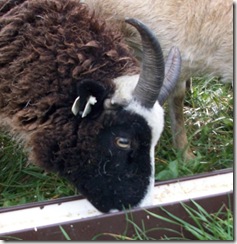 As I study the Pat Coleby mineral supplementation subject more and more, the biggest hang-up I have is over copper (Cu). I can breeze right through the advice for offering the other minerals free-choice, feeling confident in her assertion that the sheep will eat what they need and no more. And most of what’s in her recipe is fairly low-risk, even if the sheep ate a little too much. But not so with copper!
As I study the Pat Coleby mineral supplementation subject more and more, the biggest hang-up I have is over copper (Cu). I can breeze right through the advice for offering the other minerals free-choice, feeling confident in her assertion that the sheep will eat what they need and no more. And most of what’s in her recipe is fairly low-risk, even if the sheep ate a little too much. But not so with copper!
Using Wedge-Loc Brackets for Fence Braces
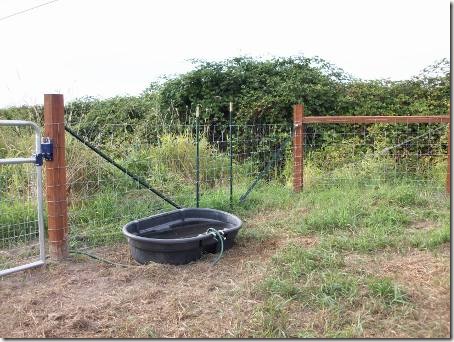 I bought some Wedge-Loc brackets in the summer of 2008 with the intention of using them to brace short sections of fencing, but only got around to using them this summer. Wedge-Loc’s modest marketing materials would imply that you should never have to build an H-brace again, thanks to their invention; but I think this is probably a bit of an exaggeration. If there is a lot of force on the H-brace, it would easily push a T-post through the soil, much more easily than a 4×4” or 6×6” wood post buried 3+ feet deep. So, these can only be used for small-potatoes applications; like for low-tensile fencing material, very short sections, and places where you least expect an animal to ram into the fence at high speed or push a lot on the fence. But, I think there do exist some scenarios where this type of brace makes sense.
I bought some Wedge-Loc brackets in the summer of 2008 with the intention of using them to brace short sections of fencing, but only got around to using them this summer. Wedge-Loc’s modest marketing materials would imply that you should never have to build an H-brace again, thanks to their invention; but I think this is probably a bit of an exaggeration. If there is a lot of force on the H-brace, it would easily push a T-post through the soil, much more easily than a 4×4” or 6×6” wood post buried 3+ feet deep. So, these can only be used for small-potatoes applications; like for low-tensile fencing material, very short sections, and places where you least expect an animal to ram into the fence at high speed or push a lot on the fence. But, I think there do exist some scenarios where this type of brace makes sense.
Continue reading “Using Wedge-Loc Brackets for Fence Braces”
New Ducklings
The “emergency replacement batch” of ducklings hatched this weekend. Three silvers, one blue, and one black. I think three of them are purebred Magpies. I’d like to get back to having a purebred flock, so that’s good.
Broken Coyote Jaw
We boiled the skull of the coyote that Kirk shot, and were surprised to have the bottom jaw come out in three pieces. It was broken clean through, with a large, shattering injury to the lower right jaw, under and behind the last tooth. Huh, I thought, did Kirk shoot him there? I didn’t think so. I knew he had gotten a good, lethal shot to the chest.
Looking back at the photos, his face showed no outward signs of injury. [Somewhat graphic pictures below, click for more if you’d like to view them and read the rest of the story.]
Mineral Madness
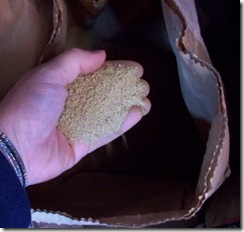 When I start researching a topic, I can really get obsessed. And such is the case with mineral supplement options for sheep. I might have just bought my bag of “sheep mineral” from the local feed store for years and not given it a second thought, had it not been for Pat Coleby’s book Natural Sheep Care. The book is a mind-boggling read, going into great depth on dozens of trace minerals, and the role each one plays in nutrition, and when deficient, in disease. When I first read this book, my reaction was “bleah!!” and I stuck it back on the shelf, because the stuff just seemed too complicated. And you would think surely the makers of my feed store mineral bag already had all this figured out, right? 😉
When I start researching a topic, I can really get obsessed. And such is the case with mineral supplement options for sheep. I might have just bought my bag of “sheep mineral” from the local feed store for years and not given it a second thought, had it not been for Pat Coleby’s book Natural Sheep Care. The book is a mind-boggling read, going into great depth on dozens of trace minerals, and the role each one plays in nutrition, and when deficient, in disease. When I first read this book, my reaction was “bleah!!” and I stuck it back on the shelf, because the stuff just seemed too complicated. And you would think surely the makers of my feed store mineral bag already had all this figured out, right? 😉
Mobile Mineral Menu for Sheep and Other Livestock
 Quite a while ago, I read Pat Coleby’s book Natural Seep Care. Then I put it on the shelf for a long time, because her assertions and suggestions are a bit overwhelming, and not easy to implement. But I’ve decided to embark on following some of her advice, including offering the sheep individual trace minerals (instead of a commercial proprietary mix) so they can eat what they crave.
Quite a while ago, I read Pat Coleby’s book Natural Seep Care. Then I put it on the shelf for a long time, because her assertions and suggestions are a bit overwhelming, and not easy to implement. But I’ve decided to embark on following some of her advice, including offering the sheep individual trace minerals (instead of a commercial proprietary mix) so they can eat what they crave.
The first challenge was figuring out a sheltered, but moveable, device in which to offer this mineral buffet, since the sheep are in ever-rotating pastures. I nagged myself to craft something from scratch, but just wasn’t getting to it. So I finally purchased two nifty mineral feeder stations.
Continue reading “Mobile Mineral Menu for Sheep and Other Livestock”
Coyote Skinning
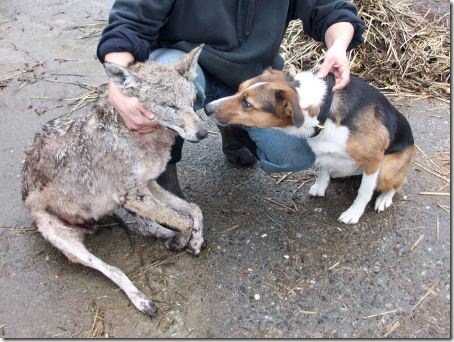 I’ve talked several times before about our coyote predation problems, and our attempt to manage coyotes partly by attempting to teach them to stay out of the yard and livestock areas, and using removal as a final option. We’ve had reasonable luck this year with shooting at them and (intentionally) missing, and having that be enough of a deterrent to keep them at a distance. But, for the ones that do keep returning and not responding to our “training” methods, eventually, we’re not going to miss! So that is what happened last week, we had one that kept lurking, boldly continuing to snag poultry from the yard, and Kirk finally got him. We don’t like to take them out, but if they are constantly killing livestock and do not respond to training, they have to go.
I’ve talked several times before about our coyote predation problems, and our attempt to manage coyotes partly by attempting to teach them to stay out of the yard and livestock areas, and using removal as a final option. We’ve had reasonable luck this year with shooting at them and (intentionally) missing, and having that be enough of a deterrent to keep them at a distance. But, for the ones that do keep returning and not responding to our “training” methods, eventually, we’re not going to miss! So that is what happened last week, we had one that kept lurking, boldly continuing to snag poultry from the yard, and Kirk finally got him. We don’t like to take them out, but if they are constantly killing livestock and do not respond to training, they have to go.
This was while I was out of town in Pullman, and Kirk called with the news. He ended up putting the coyote in the freezer to wait until I got home. It fit neatly into the empty above-the-fridge freezer that we’d recently replaced with our new French door fridge. So, we had a frozen coyote in the kitchen. 🙂 Before that though, he weighed the coyote and all the dogs. You see, we always get a kick out of people expressing great fear of coyotes, and amazement that we chase them, because they are really little dogs. Littler than our dogs. And they’re pretty chicken; they are no fools, they don’t take on something that might injure them if they don’t have to. And that was the case with this fellow, as you can see from the photo above, he’s a petite little canine, just about the same size as Maggie. Here’s how they weighed in:
Coyote: 33.5 pounds
Maggie: 42 pounds
Gene: 36 pounds
Spanky: 48 pounds
We thawed him out this weekend for processing. This coyote was actually not in good health, and his skin and tail were very mange-ey and he had some bald patches. He may not have made it through the winter on his own, and was probably targeting our poultry out of desperation for something easy enough for his unhealthy body to catch. Despite the patchy appearance, we thought it would be good practice to skin it, and once the hide was off, it looked OK. So for fun we’ll tan it for a wall-hanger, even though it’s not a fancy fur.
I’m not sure how to judge wild dog teeth for age estimation, but if this were a domestic dog, I would estimate 5-7 years old, based on the wear of the “scallops” off of the front incisors. This may be somewhat “elderly” for a coyote? They may wear their teeth faster than dogs though, so maybe he’s not quite that old. But definitely a mature male. It’s interesting to see how much longer and larger their teeth are compared to domestic dogs, definitely still designed for hunting, not kibble eating!
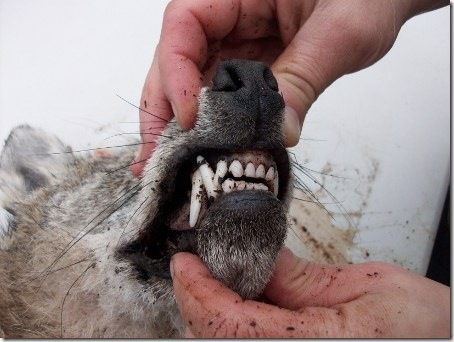
Below is how we skinned it. Warning: graphic pictures ensue, so only read on if you’re up for it! This post is in no way meant to disrespect nature or glorify killing, but to acknowledge that sometimes predators have to be killed, when they are making a habit of eating livestock and do not respond to gentler control attempts. When you do have to harvest one, you might as well make good use of the hide, and recycle the rest back to nature, so nothing is wasted. And learn some anatomy too. So, here’s how it’s done, or one way to go about it.

